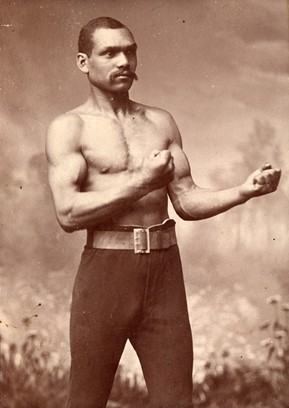George Godfrey (boxer, born 1853) facts for kids
Quick facts for kids George Godfrey |
|
|---|---|
 |
|
| Statistics | |
| Real name | George Godfrey |
| Nickname(s) | Old Chocolate |
| Rated at | Heavyweight |
| Height | 5 ft 10 in (178 cm) |
| Nationality | Canadian |
| Born | 20 March 1853 Charlottetown, Prince Edward Island |
| Died | 17 October 1901 (aged 48) Revere, Massachusetts |
| Boxing record | |
| Total fights | 46 |
| Wins | 23 |
| Wins by KO | 18 |
| Losses | 6 |
| Draws | 14 |
| No contests | 3 |
George Godfrey (born March 20, 1853 – died October 17, 1901) was a famous Black Canadian heavyweight boxer. Later in his career, the newspapers gave him the nickname Old Chocolate. He was known for being the World 'Colored' Heavyweight Champion during his time. Godfrey was honored by being added to the PEI Sports Hall of Fame in 1990.
Contents
The Life of George Godfrey
Early Years
George Godfrey was born in Charlottetown, Prince Edward Island, Canada. His family lived in a part of town called "the Bog." He learned how to box in Charlottetown from a coach named Dick Cronin.
Later, George moved to Boston, USA, to find work. He started as a porter in an office. In 1879, he won a local boxing contest in the heavyweight group. This win made him decide to become a professional boxer. Even though he was 27, which was a bit old to start boxing, he became very successful. He weighed about 175 pounds and was 5 ft 10 in (178 cm) tall. Today, he would be considered a light-heavyweight.
Boxing Career
George Godfrey had a great start to his professional boxing career. In his first eight fights, he won four, lost none, and had four draws. One of these draws was against the famous boxer Jake Kilrain.
In just his ninth professional fight, he won the World Colored Heavyweight Championship. He beat Charles Hadley by knockout in the sixth round on February 23, 1883. This was a very important title for Black boxers at the time.
On August 24, 1888, when Godfrey was 36, he fought against the well-known Australian boxer Peter Jackson. He lost this fight in the nineteenth round, which meant he lost his World 'Colored' Title. Godfrey also fought Kilrain two more times, losing both. Towards the end of his career, when he was almost 40, he also fought and lost to Peter Maher from Ireland and Joe Choynski from California. As he got older, his boxing skills started to fade. This is when some newspapers started calling him "Old Chocolate."
Godfrey spent much of his career trying to fight John L. Sullivan, who was the World Heavyweight Champion. However, Sullivan often refused to fight Black boxers. In 1881, there was a story that a bare-knuckle fight between Godfrey and Sullivan was planned. But the police in Boston stopped it because boxing was against the law there. This event made Godfrey even more famous. It also helped him get big fights against other top boxers like Kilrain, Maher, Jackson, and Choynski.
George Godfrey beat many notable fighters during his career. These included Charles Hadley, C.C. Smith, "Denver Ed" Smith, McHenry Johnson, Irish Joe Lannon, Patsy Cardiff, Steve O'Donnell, and Joe Doherty.
Later Life and Passing
George Godfrey passed away from Tuberculosis on October 19, 1901. He died at his home in Revere, Massachusetts. He owned a good amount of property in the Chelsea and Revere areas when he died. He was survived by his wife, Clara J. Godfrey, and his son, George Godfrey Jr.
Years later, another American boxer named Feab S. Williams used the ring name "George Godfrey." He also won the same championship 42 years after the original George Godfrey.
Legacy and Honors
George Godfrey's career was very important in boxing history. For many decades, the World Colored Heavyweight Championship was a way to fight against unfair racial treatment. This title helped Black boxers gain recognition and challenge the "color line" that existed in sports and society.
In 2020, author Mark Allen Baker wrote a book about The World Colored Heavyweight Championship. This book tells the story of the championship, the talented athletes who won it, and how racial barriers affected boxing.
See also
- List of bare-knuckle boxers

